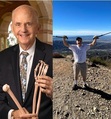Roy A. Meals's Blog
April 15, 2025
What do ligaments look like, anyway?
Ligaments hardly get any respect. By comparison, bones in natural history museums and on X-rays are fascinating. We can also marvel at dissembled ones on otherwise empty dinner plates. Muscles, too, get their due. Since they are just under the skin, we have a sense of their shape, can feel them contact and relax, and note the effects of conditioning and overexertion. Artists have sculpted bulging muscles in bronze and stone figures for thousands of years as expressions of might. Nobody has ever done the same for ligaments.
Without ligaments, however, each of us would be a bag of bones and muscles flopping about without achievement. Consider too that muscle and bone together constitute over half of our body’s weight. Ligaments, by contrast, would hardly tip the scale at all. In spite of their importance, most people (surgeons, meat cutters, and hunters excepted) have never seen a ligament in its natural state, partly because others have fewer opportunities and are less inclined to be poking around, and heating ligaments in the kitchen turns them to mush.
For clarification, ligaments are the tough, fibrous bands that connect bones together. In humans, except for three that run the length of the spine, none are longer than several inches, and many are much shorter. Only occasionally are they thicker than a shoestring, and in the fingers, they are about that wide, whereas at the hip and knee they are much wider and thicker. The gaps that ligaments span between bones are, of course, joints, and ligaments control each joint’s motion.
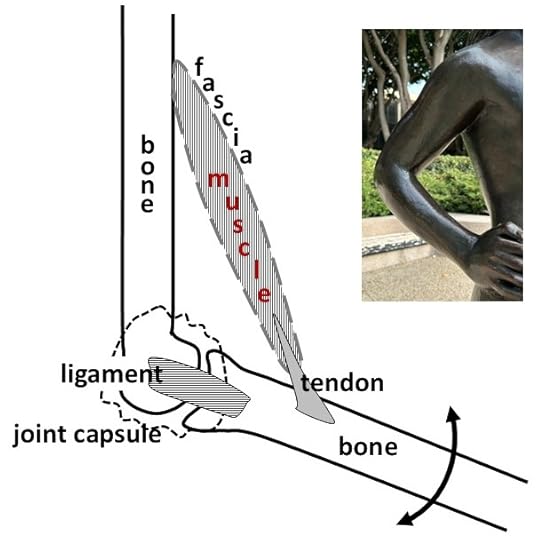
Ligaments resist stretch and appear microscopically much like tendons; and both, aptly described as connective tissues, cross joints. The elemental difference between the two is that ligaments connect bones together whereas tendons join muscles to bones.
To enhance your appreciation of ligaments, I dissected a fresh chicken. Your ligaments look identical, just larger.
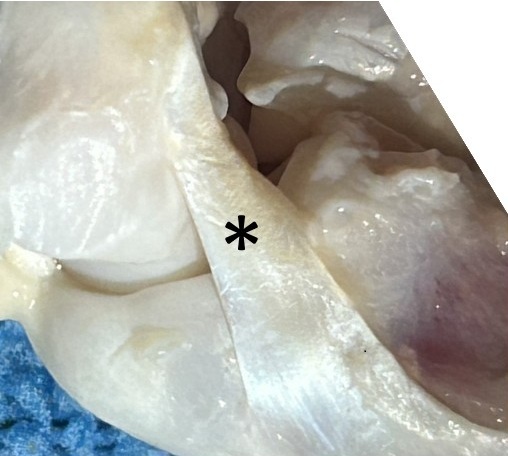
The asterisk identifies the strong ligament on the side of the elbow closest to the trunk–the medial collateral ligament. It resists side-to-side deviation of the elbow and is the cause of many baseball pitchers’ disability. (I will discuss this ailment and its treatment later.)
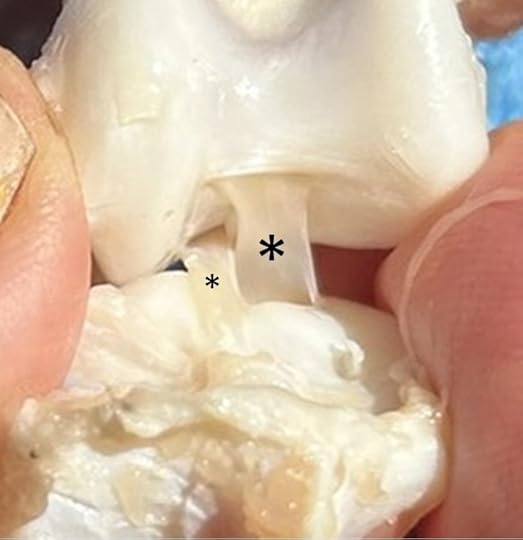
The asterisks mark the cruciate ligaments, which are located inside the knee. The smaller asterisk identifies the anterior cruciate ligament (ACL), which is prone to tear with twisting injuries. (Details later.)
This vexation also affects dogs. I am not certain about chickens.
Status of book, Ligaments, Appreciating the Bands That Bind Us
February, 2024: Publishing agreement signed with Johns Hopkins University Press
February, 2025: Completed manuscript submitted to JHUP. JHUP sends manuscript out for peer review.
April 4, 2025: Both peer reviews entirely favorable. Several images modified to improve clarity, returned to JHUP April 5, 2025 for the book to “go into production.”
Launch date anticipated for early 2026. Stay tuned for details.
The post What do ligaments look like, anyway? appeared first on MuscleAndBone.Info.
March 25, 2025
Contortionism, Part III
I thought I was finished after Parts I and II, but then a former UCLA orthopedic surgery resident who is a spine specialist in Las Vegas sent me an intriguing journal article. A group of radiologists he knows obtained MRIs on five contortionists from a Mongolian circus school. The performers ranged in age from 20 to 49. The investigators used an “open” MRI machine, which is routinely used for individuals who are claustrophobic or too large to fit into the conventional tube-like “closed” machine. This allowed them to obtain images while the performers were in their extreme spinal positions, either bending backward or forward.
The MRIs showed that the extreme flexibility required for a performer to bend forward and put their shoulders between their knees or even behind them comes from extreme flexibility in their hips. The radiologists noted that the performers seemed comfortable in this position for long periods of time.
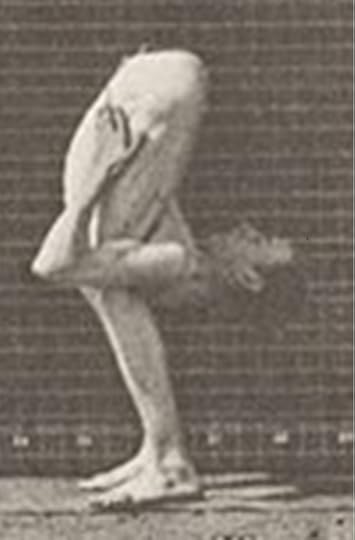
Going the other way, the flexibility required for a contortionist to lean backwards and touch the back of their head to their buttocks comes from flexibility in their neck and in their lower back. These performers can only hold this position for a few minutes before experiencing back pain.
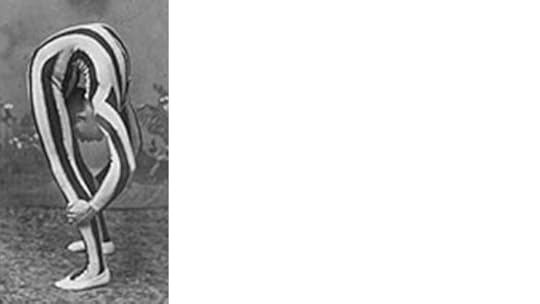
Before you consider trying these postures, understand that the MRI studies also showed chip fractures off the edges of the vertebral bodies of the backbenders. The ligaments under extreme tension pulled off bits of bone rather than elongating. The older the performer was, the more spinal segments showed these injuries.
I obtained the two photos shown here from wikimedia.org -> contortionism, where many more are archived if you are interested. The first one here was taken by Eadweard Muybridge (1830-1904). You have probably seen his “electro-photographic investigation of consecutive phases” of a running horse. (Funded by industrialist and horse breeder Leland Stanford.) Those photos proved for the first time that there are phases during a gallop when all four of a horse’s feet are off the ground at the same time. Muybridge became fascinated by the technique and used it to photograph a wide range of other animals’ gait patterns, testimony to the durability and versatility of ligaments across the animal kingdom.
The post Contortionism, Part III appeared first on MuscleAndBone.Info.
March 10, 2025
Contortionism, Part II
In my previous post, I began to describe my experience of first observing a “Flexibility 101” group lesson at the Cirque School and then a week later taking a private lesson.
After the group lesson was over, I asked several students what motivated them to contort. One, in her thirties, said that as a teenager she had been a gymnast and liked stretching again because it felt good and was more intense than yoga or Pilates. Another said that she was a pole dancer and that the class helped her keep in shape. My instructor related that she performs at private events and that her other students include ice skaters, gymnasts, and dancers. Both my instructor and the owner said that once the desired degree of flexibility is achieved it is alright to take a week off now and then without loss of bendiness. I was also impressed with how strong these people are, defying gravity with their bodies cantilevered in various unlikely positions. My instructor said that contortionists do not pump iron or need to but just gain strength by supporting their own weight in various positions. Also, stiffness with increasing age is not a given, and there are contortionists in their 60’s who still perform. It seems that the mantra “use it or lose it” holds here. (A confirmatory note: I have seen elderly people in Asian countries resting with apparent comfort in a full squat position—buttocks on heels, feet flat on the ground, waiting for a bus or chatting in the market. They have been doing it their whole life, including going to the bathroom without the aid of a raised Western-style toilet.)
Contortion originated in the Far East about 1000 BCE when Buddhist dances incorporated movements of great flexibility. It has become a symbol of national pride among Mongolian nomads and simulates the patterns of their fine arts. Bendy people in other cultures have followed, and some of their achievements are preserved on clay or in clay.
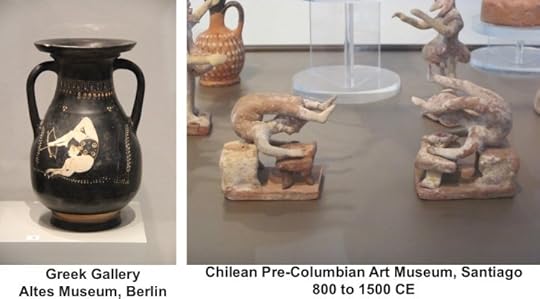
The most difficult pose in contortion is named for H. B. Marinelli (1864-1924). Beginning when he was seven, he was billed as “The Boneless Wonder.” With his teeth he gripped a mouthpiece fixed two feet off the ground and then hyperextended his back until his buttocks contacted the back of his head with his feet extended out in front.
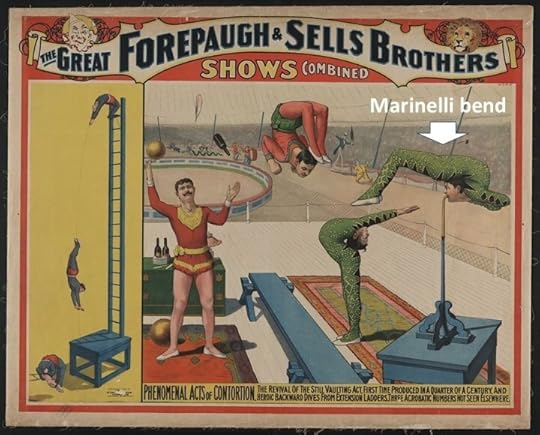
Mongolian contortionists have extended this amazing feat of strength and flexibility by having a second contortionist performs a handstand on top of the one in the Marinelli bend—all supported through just the bender’s jaw and neck—a double Marinelli bend. At least once, and confirmed on a YouTube video, contortionists have achieved a triple Marinelli bend. Equally astounding, another video shows a single Marinelli bender, but she holds this pose for over four minutes—a Guinness World Record. I’d try a Marinelli bend but my dentist advises otherwise.
The post Contortionism, Part II appeared first on MuscleAndBone.Info.
February 19, 2025
Contortionism, Part I
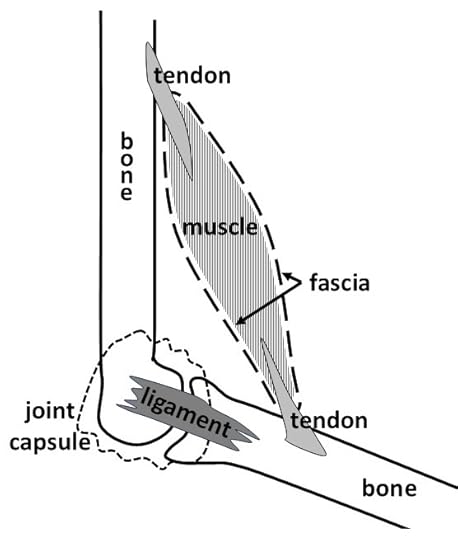
It has been almost a year since I have reported on muscles and bones. That is because I have been working hard on a related topic that binds the musculoskeletal system together–ligaments. In their classic form ligaments span from bone to bone and allow joints to move in some directions and not in others, akin to hinge pins in the built world.
The manuscript is now at the publisher. Whew. As part of doing research for the book, I decided to “walk the walk” and give my ligaments a workout by taking a contortion lesson. Contortion is the performance art where extremely limber individuals showcase their flexibility in a choreographed set of moves and poses, often to music and while smiling continuously. For example, Cirque du Soleil features contortionists who dazzle audiences with their seemingly impossible postures, sometimes braced on just their hands, and then perhaps supporting one or more other performers on top of them. Some of the artists can also knot themselves up so that it is nearly impossible to describe how their various joints are positioned to achieve the pose.
A quick internet search provided the ten best contortion training facilities in Los Angeles, and I chose the Cirque School in Hollywood. Their website indicated that their performance-art classes included flexibility, handstands, trapeze, as well as aerial sessions for hoop, straps, rope, and fabric. Their website also had words of encouragement. “For anybody with any body.” That convinced me. After observing their Flexibility 101 class one evening, a week later I took a private lesson with the same instructor. Both times, other classes were going on in this large warehouse, which except for the entry area, was completely decked in thick squishy mats. Ropes, trapezes, and large rings dangled from the rafters. All the other students, predominately but not entirely women, were decades younger than me. To my surprise, not everyone was wiry; some approached stocky. (I consider myself in between.) I talked briefly to several students after class, to my instructor at length during my private session, and later to the owner, who formerly performed in the Cirque du Soleil. Here is what I learned.
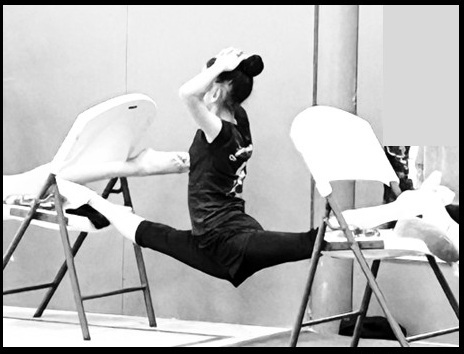
Most contortionists discovered at an early age that they had some joints, particularly spine and hips, that were particularly “bendy.” (At age four, one famous contortionist could jump off the top of a bunk bed and land in a full split. Yow!) With the discovery of their unusual flexibility, they accentuate it by stretching daily for at least several hours. Contortionists generally are either “back benders” who can lean over backward and put their head between their knees or “front benders” who can lean forward and put their head between their ankles. However, that degree of suppleness in the spine ligaments in both directions is unusual. Hip flexibility is gained and maintained by prolonged positioning in a split-leg posture and performing “oversplits,” where the performer’s heels rest on two chairs with the body otherwise unsupported. It is not supposed to hurt, and apparently it does not, because I have seen people in that position blithely studying their cellphones or fingernails while the collagen in their ligaments is remodeling.
For me, even approaching 50% of a split position on the mat was what I describe as “sweet agony,” almost intolerable. My instructor said that it takes a month or two of regular work to stretch the muscles and keep them from reactively contracting and resisting the stretch. Then over the following months, the ligaments will begin to respond. During my hour-long session, I think I stretched every joint in my body except for my jaw and some toes—far deeper stretches than I have ever attempted or achieved in yoga or Pilates. I was perspiring at the end of my flexibility session, felt great for the rest of the evening, and, much to my relief, was not sore the next day. I continue to do some of the stretches, but I have no plans to run off and join the circus.
The post Contortionism, Part I appeared first on MuscleAndBone.Info.
April 24, 2024
Random Attractions Just Inside LA City Limits
Stay current with the adventure. Follow LACityLimits on social media.
FacebookInstagramTwitterTravel Town in Griffith Park is mostly about historic railroad locomotives and rolling stock but also displays trucks, autos, and wagons, both circus and milk. Ride the miniature railroad to survey the exhibits. Walk close to the massive beasts. Learn the differences between a 4-8-8-4 & a 4-4-0.
S. Korea gifted a huge, 17-ton, bronze bell to the US to commemorate America’s 200th birthday. It resides in a pagoda-like pavilion on a grassy knoll overlooking LA harbor with Catalina Island not far away. On special days, the bell sounds its deep tone when struck with a log.
SQRD Lab ensures that legit weed is free from heavy metals, pesticides, bacteria, fungus & other yuckies. The lab samples every 50 pounds of leaves, gummies & brownies. Such tested & certified weed is likely only 20-30% of marijuana sold in CA. Health risks of illegal dope? ???
An old military barrack in San Pedro houses the Belmont Shores Model Railroad Club. The layout is 25×90′ The main line is a scale 20 mi. Members bring their engines & rolling stock to run through the wilderness, rural & urban scenes reflecting the ’40s & 50s. Awesome details. Fun.
The Marine Mammal Care Center, San Pedro, takes in malnourished, entangled, ill, & injured sea lions & seals, returns them to health, then tags & releases them. Current guest list & #s: elephant seals 29, harbor seals 2, sea lions 48. Sea lions can walk on land & bark. Seals can’t.
Moon jellies. Cabrillo Marine Aquarium, San Pedro. They are 90% water & wax & wane in size from 1-12″ according to food availability. All 7 species of sea turtles eat them, & they are the sole source for leatherbacks, weighing up to 2000 lbs. Fortunately, moon jellies are common.
Platinum Props on Rosecrans Ave. has something for everyone, especially if planning a birthday party, high school prom, wedding, or business event. Need a full-scale giraffe, robot, British phone booth, ninja turtle, Spiderman, gas pump, triceratops, nutcracker soldier, 6′ Oscar?
Over 100 displaced, rescued, & zoo-born wild animals call the Wildlife Learning Center, Sylmar CA, home. These include a sloth, bald eagle, blue & red macaws, porcupines, marmosets. Private interactive tours allow close-ups with a hedgehog, armadillo, others. I fed the giraffe.
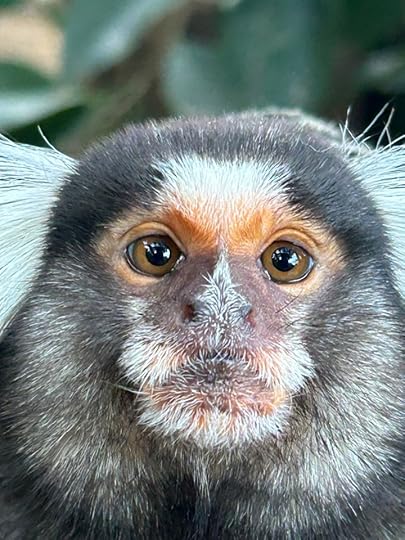
Well-known recreational activities in Griffith Park include golf, tennis, hiking, horseback riding, star gazing, concert going and picnicking. Less well-known historical elements: a seminal moment for Babe Ruth, internment for WWII prisoners, and the old zoo that closed in 1965.
Griffith Park, a 7 sq. mi. urban jewel, offers golf, tennis, zoo, observatory, train rides, Holllywood sign, amphitheater, museum, picnic areas, old landfill, and remarkably, wilderness hiking trails where one can lose all sense of civilization, maybe even spot a mountain lion.
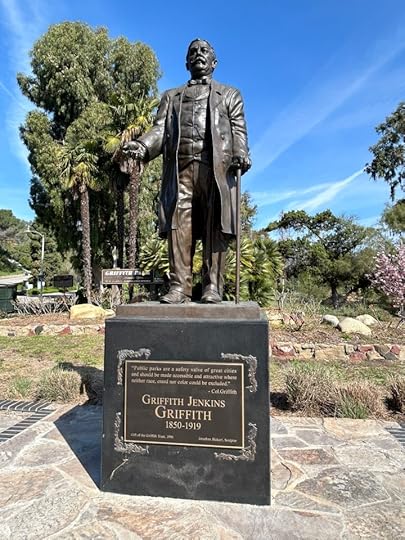
Kindred Spirits Care Farm joins rescued animals, at-risk people & sustainable farming. All benefit. The animals’ success stories can inspire people who have experienced abuse, abandonment or neglect themselves. Also, learning to grow food aids body, mind & spirit. Open Sundays.
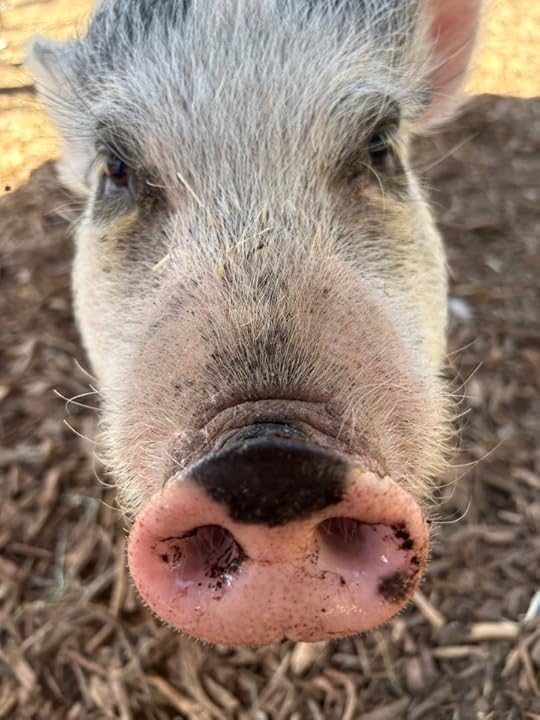
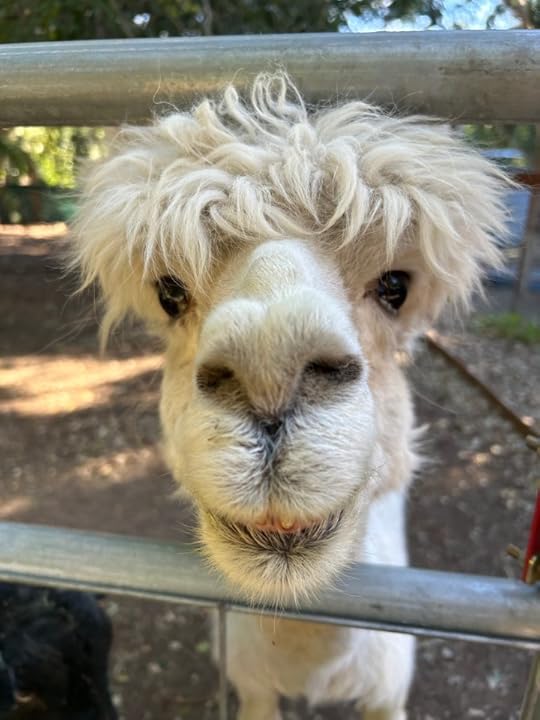
Hiram Sims, poet & educator, owns Sims Library of Poetry, which contains 10,000 volumes, 3 by Sims. Hiram’s interest in poetry began in middle school. A poem he wrote softened a girl’s heart sufficiently that she went with him for 2 weeks. Powerful words. Readings most Saturdays.
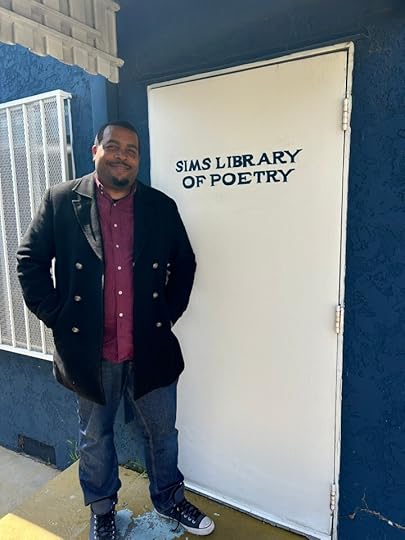
JB Nethercutt prospered after going into business with his aunt, who founded Merle Norman Cosmetics. His collection of 130 perfectly restored and fully operative cars, often winners of Best in Show awards, is on display in Sylmar. It’s a duesy. It’s free.
Surprise! Ethiopian food in horse country at N end of San Fernando Valley! Along with American & Mexican hearty breakfast/lunch fare, two Ethiopian/American sisters also serve traditional food & injera flatbread with spices & teff flour imported from their native country. Worth a trip. Vegetarian plate with lentils, chickpeas, yellow peas, red beets, cabbage, and collard greens on injera flat bread, made from teff flour..
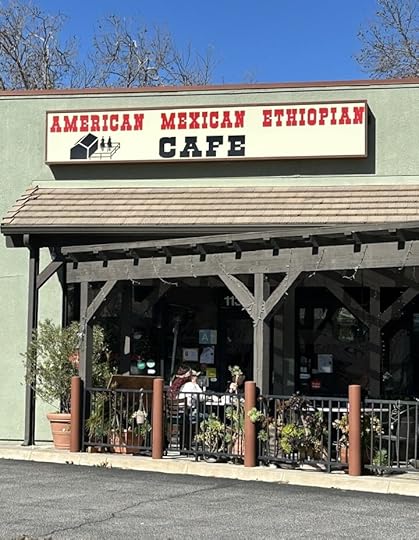
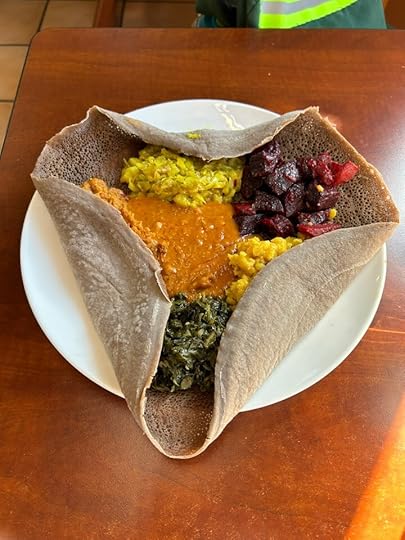
Inside a huge warehouse in Sylmar, Mb2 Raceway offers electric go-karting. Don a helmet, strap yourself in and fantasize Formula 1. Sitting inches off the track, the speed seems insane. The G-forces shout “spinout inevitable,” but it never happens. My best lap time: 27 secs. What’s yours?
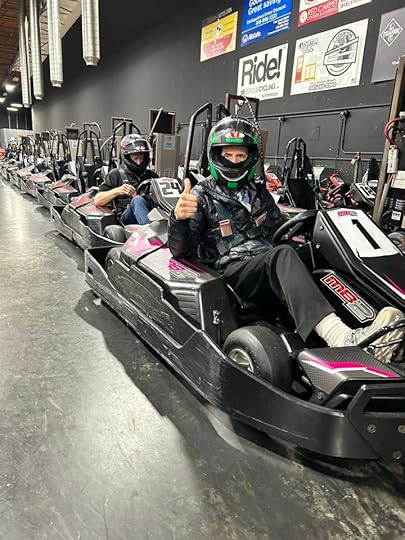
A natural spring behind University High School in West LA was the site of a Tongva village from 5000 BCE. From his ship in 1769, Spanish explorer Portola saw smoke from the village and visited. Friendly terms slowly decayed. Tongva descendants maintain this sacred site today.
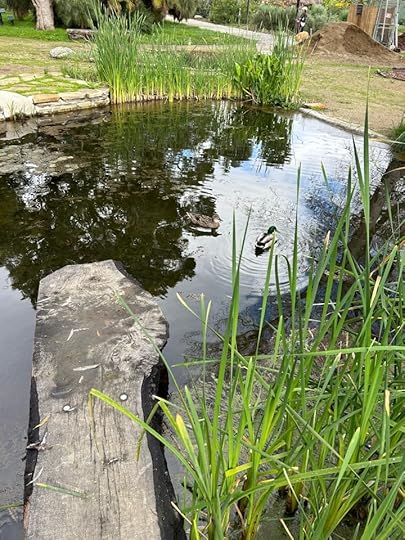
Discovery Cube is billed as a children’s museum, but adults have a great time too. Highly interactive learning. Make giant smoke rings. Sort recyclables against time. Play goalie & block shots. Hoist yourself with a block & tackle. Shop for healthy groceries & get scored. FUN!
In I-210’s shadow in Lake View Terrace, LA Succulents’ huge greenhouse nurtures an amazing array of spiny plants. The owner started w/ patio hobby cacti, quit his day job, now in big-time business. Ships widely, but only to SW in winter since plants are cold intolerant. Stop by!
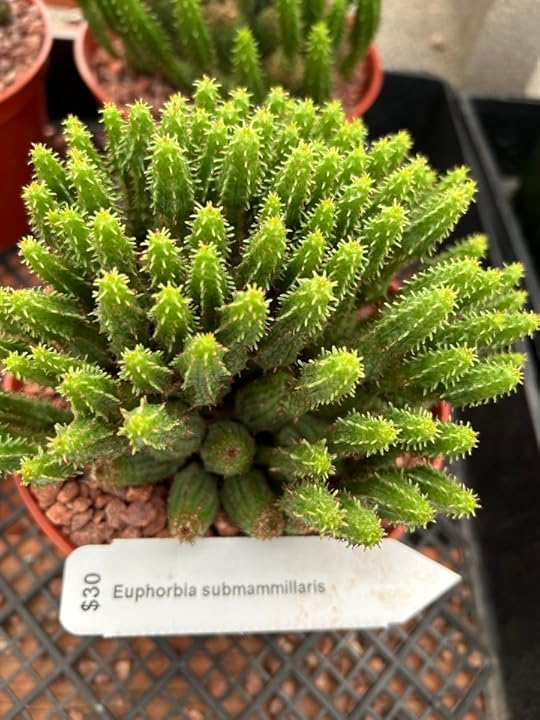
Tujunga, at Mt. Lukens’ base, was remote from LA in the early 1900’s. Residential architecture was eclectic in the absence of building codes. Abundant local stone led to self-made homes popping up overnight. Despite earthquakes, some remain. Other wild styles coexist.
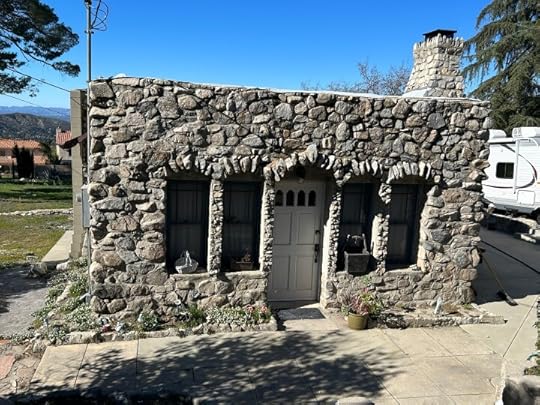
The first segment of my 342-mile walk around the city limits of Los Angeles is hiking down to “civilization” from the top of Mt. Lukens (5075′ high), which is in the far NE corner of the San Fernando Valley. In the far distance, San Pedro and the Pacific Ocean are faintly visible about 35 miles away as the crow flies, but about 160 miles away as my feet walk.
The post Random Attractions Just Inside LA City Limits appeared first on MuscleAndBone.Info.
Random Points of Interest Encountered Just Inside the LA City Limits
Stay current with the adventure. Follow LACityLimits on social media.
FacebookInstagramTwitterTravel Town in Griffith Park is mostly about historic railroad locomotives and rolling stock but also displays trucks, autos, and wagons, both circus and milk. Ride the miniature railroad to survey the exhibits. Walk close to the massive beasts. Learn the differences between a 4-8-8-4 & a 4-4-0.
S. Korea gifted a huge, 17-ton, bronze bell to the US to commemorate America’s 200th birthday. It resides in a pagoda-like pavilion on a grassy knoll overlooking LA harbor with Catalina Island not far away. On special days, the bell sounds its deep tone when struck with a log.
SQRD Lab ensures that legit weed is free from heavy metals, pesticides, bacteria, fungus & other yuckies. The lab samples every 50 pounds of leaves, gummies & brownies. Such tested & certified weed is likely only 20-30% of marijuana sold in CA. Health risks of illegal dope? ???
An old military barrack in San Pedro houses the Belmont Shores Model Railroad Club. The layout is 25×90′ The main line is a scale 20 mi. Members bring their engines & rolling stock to run through the wilderness, rural & urban scenes reflecting the ’40s & 50s. Awesome details. Fun.
The Marine Mammal Care Center, San Pedro, takes in malnourished, entangled, ill, & injured sea lions & seals, returns them to health, then tags & releases them. Current guest list & #s: elephant seals 29, harbor seals 2, sea lions 48. Sea lions can walk on land & bark. Seals can’t.
Moon jellies. Cabrillo Marine Aquarium, San Pedro. They are 90% water & wax & wane in size from 1-12″ according to food availability. All 7 species of sea turtles eat them, & they are the sole source for leatherbacks, weighing up to 2000 lbs. Fortunately, moon jellies are common.
Platinum Props on Rosecrans Ave. has something for everyone, especially if planning a birthday party, high school prom, wedding, or business event. Need a full-scale giraffe, robot, British phone booth, ninja turtle, Spiderman, gas pump, triceratops, nutcracker soldier, 6′ Oscar?
Over 100 displaced, rescued, & zoo-born wild animals call the Wildlife Learning Center, Sylmar CA, home. These include a sloth, bald eagle, blue & red macaws, porcupines, marmosets. Private interactive tours allow close-ups with a hedgehog, armadillo, others. I fed the giraffe.

Well-known recreational activities in Griffith Park include golf, tennis, hiking, horseback riding, star gazing, concert going and picnicking. Less well-known historical elements: a seminal moment for Babe Ruth, internment for WWII prisoners, and the old zoo that closed in 1965.
Griffith Park, a 7 sq. mi. urban jewel, offers golf, tennis, zoo, observatory, train rides, Holllywood sign, amphitheater, museum, picnic areas, old landfill, and remarkably, wilderness hiking trails where one can lose all sense of civilization, maybe even spot a mountain lion.

Kindred Spirits Care Farm joins rescued animals, at-risk people & sustainable farming. All benefit. The animals’ success stories can inspire people who have experienced abuse, abandonment or neglect themselves. Also, learning to grow food aids body, mind & spirit. Open Sundays.


Hiram Sims, poet & educator, owns Sims Library of Poetry, which contains 10,000 volumes, 3 by Sims. Hiram’s interest in poetry began in middle school. A poem he wrote softened a girl’s heart sufficiently that she went with him for 2 weeks. Powerful words. Readings most Saturdays.

JB Nethercutt prospered after going into business with his aunt, who founded Merle Norman Cosmetics. His collection of 130 perfectly restored and fully operative cars, often winners of Best in Show awards, is on display in Sylmar. It’s a duesy. It’s free.
Surprise! Ethiopian food in horse country at N end of San Fernando Valley! Along with American & Mexican hearty breakfast/lunch fare, two Ethiopian/American sisters also serve traditional food & injera flatbread with spices & teff flour imported from their native country. Worth a trip. Vegetarian plate with lentils, chickpeas, yellow peas, red beets, cabbage, and collard greens on injera flat bread, made from teff flour..


Inside a huge warehouse in Sylmar, Mb2 Raceway offers electric go-karting. Don a helmet, strap yourself in and fantasize Formula 1. Sitting inches off the track, the speed seems insane. The G-forces shout “spinout inevitable,” but it never happens. My best lap time: 27 secs. What’s yours?

A natural spring behind University High School in West LA was the site of a Tongva village from 5000 BCE. From his ship in 1769, Spanish explorer Portola saw smoke from the village and visited. Friendly terms slowly decayed. Tongva descendants maintain this sacred site today.

Discovery Cube is billed as a children’s museum, but adults have a great time too. Highly interactive learning. Make giant smoke rings. Sort recyclables against time. Play goalie & block shots. Hoist yourself with a block & tackle. Shop for healthy groceries & get scored. FUN!
In I-210’s shadow in Lake View Terrace, LA Succulents’ huge greenhouse nurtures an amazing array of spiny plants. The owner started w/ patio hobby cacti, quit his day job, now in big-time business. Ships widely, but only to SW in winter since plants are cold intolerant. Stop by!

Tujunga, at Mt. Lukens’ base, was remote from LA in the early 1900’s. Residential architecture was eclectic in the absence of building codes. Abundant local stone led to self-made homes popping up overnight. Despite earthquakes, some remain. Other wild styles coexist.

The first segment of my 342-mile walk around the city limits of Los Angeles is hiking down to “civilization” from the top of Mt. Lukens (5075′ high), which is in the far NE corner of the San Fernando Valley. In the far distance, San Pedro and the Pacific Ocean are faintly visible about 35 miles away as the crow flies, but about 160 miles away as my feet walk.
The post Random Points of Interest Encountered Just Inside the LA City Limits appeared first on MuscleAndBone.Info.
April 10, 2024
It is all downhill from here.
Los Angeles is the tallest city in the United States, measuring in elevation from sea level along the coast at Pacific Palisades, Venice, and San Pedro to 5075 feet high at the top of Mt. Lukens. The peak is in the far northeast corner of the San Fernando Valley and just barely inside the LA City limits. You could almost kick a rock off the top into Angeles National Forest.
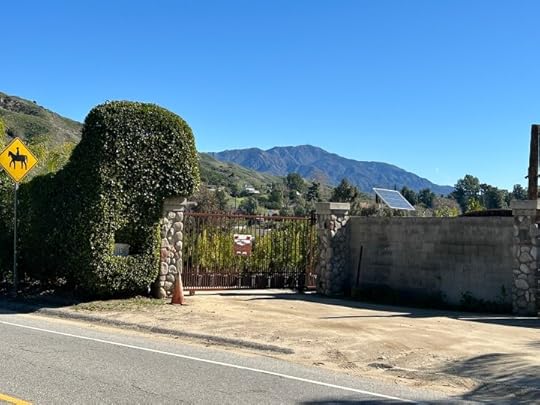
Mt Lukens’ profile is far from iconic, only rarely snow covered, and whatever natural beauty it might have is marred by an array of communication towers that dominate the summit. It does not get much respect. Most Angelenos have never heard of it. Nonetheless, it seemed like the logical place to begin my walk around the Los Angeles city limits–a counterclockwise, 342-mile ziggy loop.
My first five miles, however, didn’t count, because that was the distance from the trailhead at the edge of development up a steep trail through chaparral to the summit. Canyons and ridges dropped away with breathtaking steepness in multiple directions, and looking toward “civilization,” the first signs of humans were vast areas of concrete pavement lining the outlets of the largest canyons. These are “catchment basins” designed to protect the adjacent residential neighborhoods from torrents of muddy water and debris that threaten the area during the rainy season. Looking farther in the distance, downtown LA was silhouetted to the east and in the far distance, about 35 miles away, the skyline of downtown Long Beach, just outside the LA City limits, was contrasted against the shimmering Pacific Ocean. Twenty-five miles beyond that, Catalina Island’s outline was faintly visible. It was a spectacular panorama, which, for a moment, dissolved my trepidations about the jaunt.
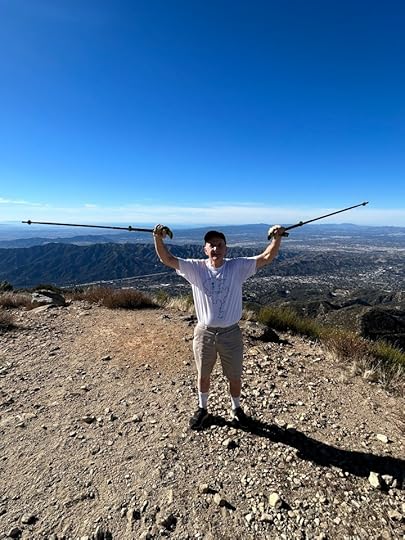
My hiking buddy, Thomas, and I took pictures of each other with the city in the background and then started walking the line—about six miles via another slightly less steep trail back to civilization. There were other trails that wandered off in several directions, none of them were marked with more than a steel post, some not at all. Thomas, a more experienced hiker of the California wilderness than I, was comfortable with such limited directional guidance, and with the assistance of the AllTrails smartphone app, we made it down with only several wrong turns, which AllTrails quickly alerted us to. It was good that he had downloaded the app and map, because even with civilization visible in the distance and with multiple communication towers looming above us, cell phone service was spotty at best.
Portions of our path down were on fire roads suitable for four-wheel drive vehicles, and we met a few intrepid mountain bikers and several hikers, some with their dogs. Other portions were narrow tracks with vegetation so close that it snagged our hiking poles with every swing. The worst part, however, was the multitude of fist-sized rocks that seemed to be annoyingly located anywhere I might want to plant my foot. Try to step around them or balance on top of them? I don’t remember which I was trying to do when I fell sideways across my trekking pole, breaking its aluminum shaft. But maybe it broke my fall sufficiently that I ended up with only a few knee and elbow scuffs. (Later at home I resorted on my orthopedic skills to repair the broken pole. It no longer collapses for transit and storage, but it is as stout and supportive as before.) Five miles down, 337 to go. The panorama from the top sticks in my mind—a good way to start an adventure.
For the next several days, however, I was sore, not from the fall, but from delayed onset muscle soreness in my calves. Despite having trained beforehand on some seriously steep trails and streets in my neighborhood, my calves were still not conditioned for the nearly 3000-foot descent from summit to trailhead. Some people toss around the acronym DOMS when discussing delayed onset muscle soreness as if that makes them sound knowledgeable. They aren’t. Nobody is. I will put my orthopedic-surgeon hat on for a minute.
A buildup of lactic acid is a frequently implicated culprit; and muscle contractions do produce lactic acid, but it is metabolized in an hour. DOMS typically does not develop for another day or two. It most frequently occurs when a muscle repeatedly gets longer rather than shorter while it is contracting, which may sound confusing. Consider, for instance, performing an elbow curl while holding a dumbbell. Your biceps contracts, and the dumbbell comes up to your shoulder. Now lower the weight slowly. The biceps is still firing, but it is getting longer as it allows the elbow to slowly straighten. The calf muscles do the same thing with downhill walking. Not only is the cause of DOMS unclear, so is the best treatment. Anecdotal advice abounds regarding the purported benefit of ice, heat, foam rolling massage, light exercise, and herbal preparations. None of the treatments are supported by good science. Time heals all wounds, and once the DOMS-affected muscle recovers, it is resistant to a repeat bout, at least for a while. I will be interested in seeing if I develop DOMS again on the way down from Mt. Lukens after celebrating the end of my trip.
The post It is all downhill from here. appeared first on MuscleAndBone.Info.
March 12, 2024
MuscleAndBone Stretches Out
After regularly informing broadly about the musculoskeletal system for six and a half years, the website has been inactive for the past three months. Why?
I am fine, and I certainly have not run out of topics to discuss. Rather I have been expanding the scope of my interests, and doing so has proved to be an all-consuming effort.
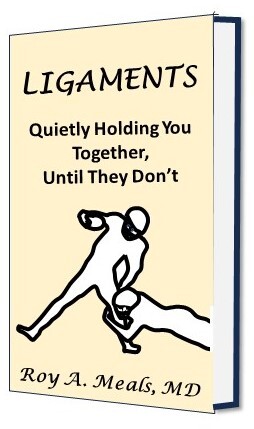
First, I just signed a contract to write Ligaments, Quietly Holding You Together Until They Don’t. This book will complete my musculoskeletal trilogy. Whereas tendons connect muscles to bones, ligaments are the unsung fibrous straps that connect bones to bones. They serve the same purpose as hinge pins, and without them our muscles and bones would flop about devoid of purposeful movement. The topic is as wide-ranging as bone and muscle and will include interesting information on career-ending sports injuries, cellulite, flat feet, artificial ligaments, Cirque du Soleil gymnasts, massage therapy, and contortionism. I will soon begin mixing in ligament topics with further posts about muscles and bones.
Second, I am intensely exercising my bones, muscles, and ligaments on an urban adventure. I have started walking the 342-mile perimeter of the Los Angeles City Limits. I am progressing in roughly 10-mile segments twice a week, stopping at points of interest and talking to people I encounter. The preparation took months. I scrutinized maps to determine the highly convoluted street-by-street boundary lines and then identified museums, one-off shops and “best of” eateries, public art, graves of famous people, infrastructure, and noteworthy architecture among other attractions that lie closer than a mile inside the boundary. This list contains over 200 places I plan to visit. Trying to line up these stops in a semi-direct path has been even more tedious since opening hours and opening days vary and sometimes freeways and golf courses cut across what would otherwise be a direct footpath between points. Like any adventure, I am coming across unanticipated gems, Who knew there would be a guinea pig rescue mission, a sacred Native American springs, and an amphitheater where one can cheer for their favorite professional video gamer?
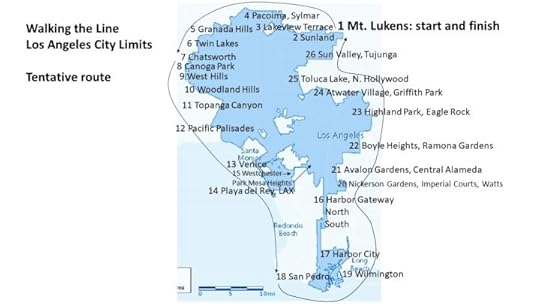
Periodically I will include essays about my urban exploration here at MuscleAndBone.info. I have also started and will continue making frequent brief posts on social media (another major learning curve): Facebook, X (Twitter), and Instagram. I would love to have you follow me on one of these platforms. I am making amazing discoveries and would like to share them, even if it is just an image of a beautiful flower, an amusing sign, or a carefully restored car. Can my trek motivate you to get out of your own neighborhood and out of your car? We’ll see.
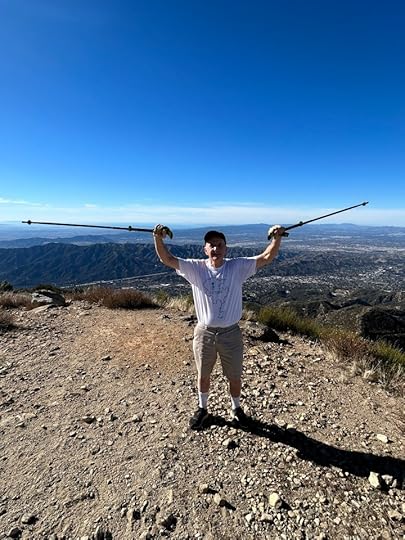
The post MuscleAndBone Stretches Out appeared first on MuscleAndBone.Info.
December 4, 2023
The Perfect Holiday Gift: Siblings
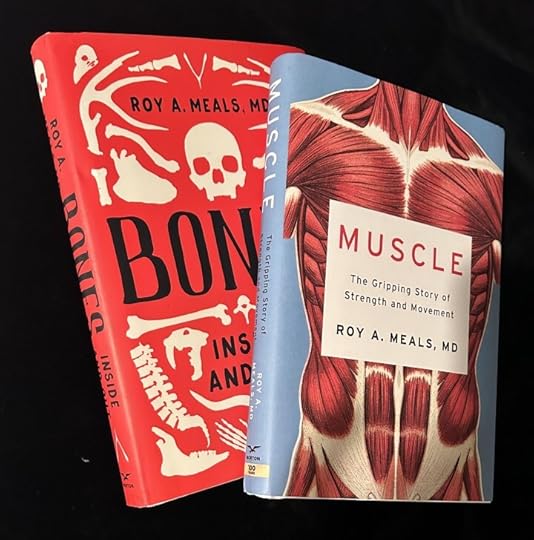
Before you saw this image, did the headline make you think that human trafficking was involved? Absolutely not. Rather these entirely legal and most thoughtful gifts merely require a visit to your favorite bookstore or the publisher’s website.
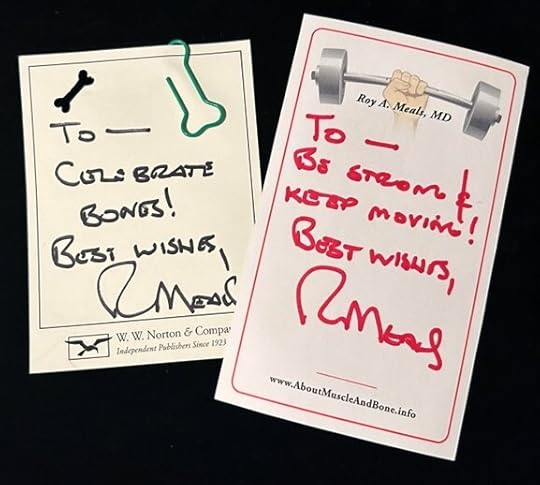
What’s more, when you contact me with your snail mail address and the names of those who are receiving Bones, Muscle, or both, I will send you personalized bookplates that you can insert into these coveted first editions.
Happy Holidays!
For further gift ideas, here are the blog posts from past Decembers: Holiday Gift Guide for Frugal Bone Lovers, Holiday Gift Guide for Discerning Bone Lovers, Extravagant Gifts for Bone Lovers
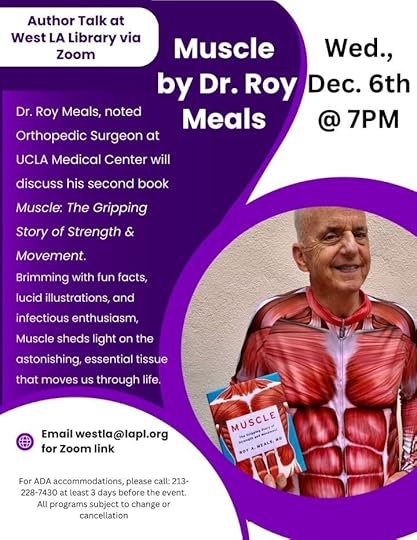
Learn more about Muscle. Join the Zoom interview with Chrissy Carr, Librarian at the Los Angeles Public Library. Wednesday, December 6, 2023, at 7 pm PST.
https://lapl.zoom.us/j/89419450496?pwd=WDZOdlV6Nkt1TTBNZkpuS1loWGFodz09
Meeting ID: 894 1945 0496 Passcode: muscle
The post The Perfect Holiday Gift: Siblings appeared first on MuscleAndBone.Info.
November 21, 2023
How do you know it’s really turkey?
At this time in years past, I have posted information about turkeys so you can sustain table talk on Thanksgiving once everyone has thoroughly hashed sports and politics.
2017 Twelve No-Fail Conversation Starters Regarding Wishbones.
2018 It Takes a Turkey to Call a Turkey.
2019 Wishbone-related Topics to Bring Up (Or Not) at Thanksgiving.
2021 A Bone-Lover’s Thanksgiving Nightmare.
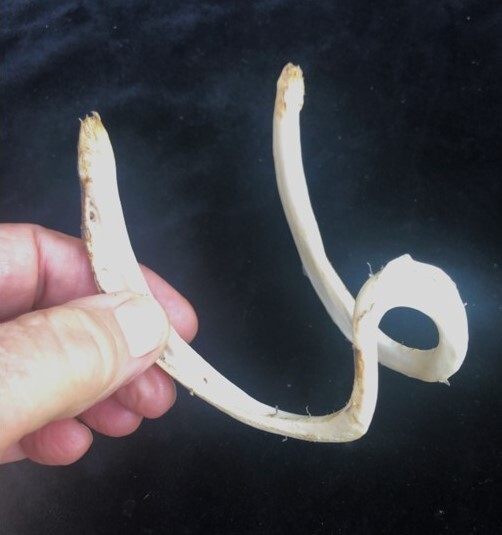
If you need fresh material this year, consider the answer to the title question, which is, “Ask to see the wishbone.” Here’s why.
This past summer, an outdoorsman friend of mine in Alaska sent me this bone, which he had picked up on the tide flats in Prince William Sound. No other bones were around to help identify this one’s original owner, and neither one of us had previously seen anything similar. By its heft, color, and appearance, it was clearly bone, but it did not have any areas where it would have contacted other bones. Hmmm… I sent photos of this mystery bone to several friends of mine at natural history museums. Even though several were experts in dinosaurs or other unlikely suspects, I asked them to forward the images to any of their colleagues who might be able to help. They did. It is a furcula, i.e., wishbone, but clearly not from a turkey. (The furcula is a fusion of the collar bones seen in most birds and some non-avian dinosaurs. In birds, it strengthens the breast bone and ribs to facilitate flight.) (Disclosing these facts alone should get you respect and extra pumpkin pie.)
The Idaho Virtual Museum includes a treasure trove of beautifully photographed individual bones from nearly 200 mammals and 100 birds, many courtesy of the Smithsonian Institution. The mystery bone looks quite similar to the furcula images for the Canada goose and the tundra swan, both of which could plausibly be in the vicinity of Prince William Sound.
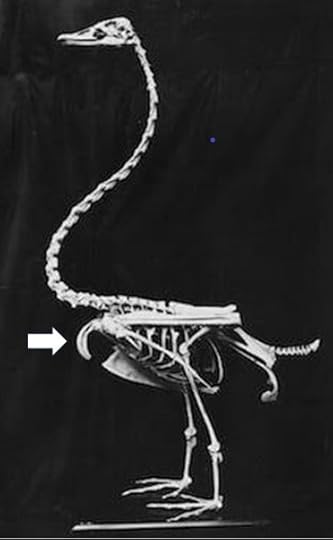
Next, I wondered, where does this sizeable bone reside in these long-necked creatures, under the chin or near the ribs? I stumbled on this image of an extinct New Zealand swan, which reveals the answer.
I also discovered that far beyond the iconic shape of chickens’ and turkeys’ wishbones, furculas come in a wide variety of shapes, which may not make them particularly useful for making wishes, but at least they can suggest the provenance of the bird at your holiday feast.
Happy Thanksgiving!
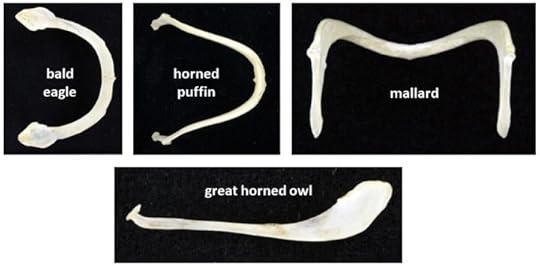
The post How do you know it’s really turkey? appeared first on MuscleAndBone.Info.

